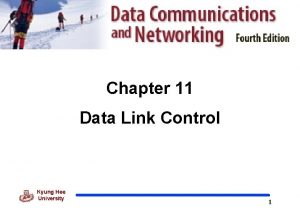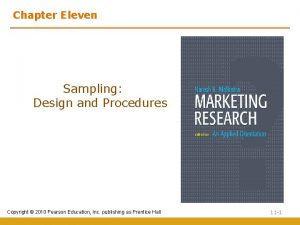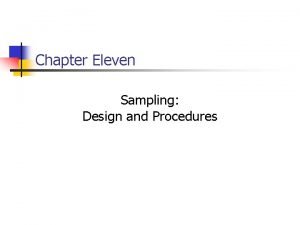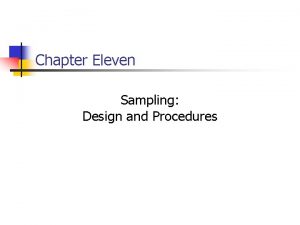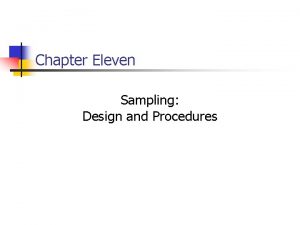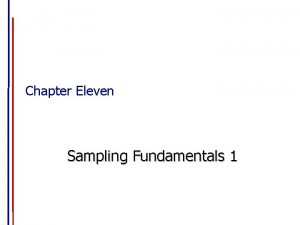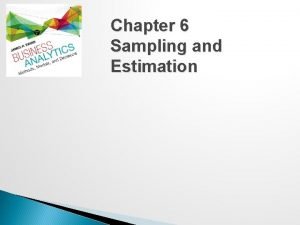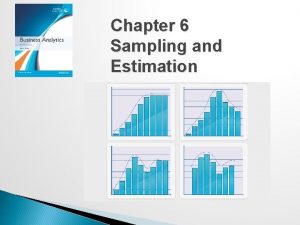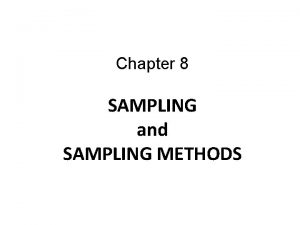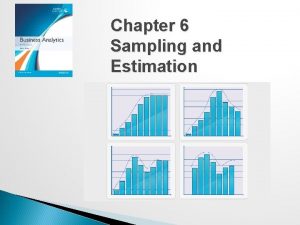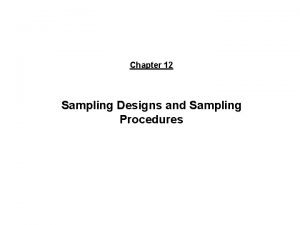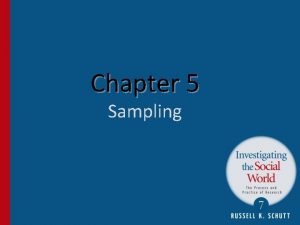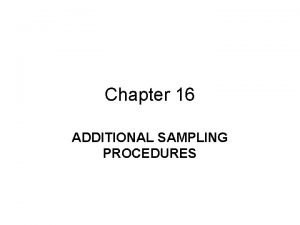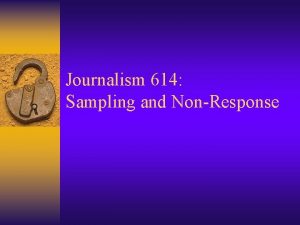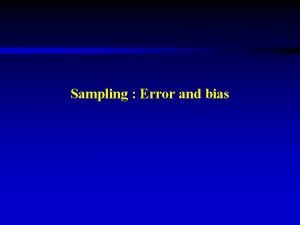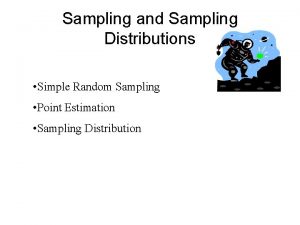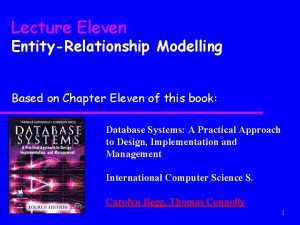Chapter Eleven Sampling Design and Procedures Copyright 2010



























- Slides: 27

Chapter Eleven Sampling: Design and Procedures Copyright © 2010 Pearson Education, Inc. publishing as Prentice Hall 11 -1

The Sampling Design Process Define the Population Determine the Sampling Frame Select Sampling Technique(s) Determine the Sample Size Execute the Sampling Process Copyright © 2010 Pearson Education, Inc. publishing as Prentice Hall 11 -2

Define the Target Population The target population is the collection of elements or objects that possess the information sought by the researcher and about which inferences are to be made. The target population should be defined in terms of elements, sampling units, extent, and time. • An element is the object about which or from which the information is desired, e. g. , the respondent. (e. g. Male or Female) • A sampling unit is a unit containing the element. (e. g. Households). • Extent refers to the geographical boundaries. (e. g. Metropolitan Atlanta) • Time is the time period under consideration. (e. g. 2016) Copyright © 2010 Pearson Education, Inc. publishing as Prentice Hall 11 -3

Determine the Sampling Frame: A representation of the elements of the target population. It consists of a list or set of directions for identifying the target population. Example of a sampling frame include the telephone book, a city directory or a map. Copyright © 2010 Pearson Education, Inc. publishing as Prentice Hall 11 -4

Sampling Techniques Nonprobability Sampling Techniques Convenience Sampling Judgmental Sampling Simple Random Sampling Systematic Sampling Probability Sampling Techniques Quota Sampling Stratified Sampling Copyright © 2010 Pearson Education, Inc. publishing as Prentice Hall Snowball Sampling Cluster Sampling Other Sampling Techniques 11 -5

Sample Sizes Used in Marketing Research Studies Copyright © 2010 Pearson Education, Inc. publishing as Prentice Hall 11 -6

Execute the Sampling Process Execution of the sampling process requires a detailed specification of how the sampling design decisions with respect to the population, sampling frame, sampling unit, sampling technique, and sample size are to be implemented. Copyright © 2010 Pearson Education, Inc. publishing as Prentice Hall 11 -7

Convenience Sampling Convenience sampling attempts to obtain a sample of convenient elements. • Often, respondents are selected because they happen to be in the right place at the right time. • Use of students, and members of social organizations • Mall intercept interviews without qualifying the respondents • Department stores using charge account lists • “People on the street” interviews Copyright © 2010 Pearson Education, Inc. publishing as Prentice Hall 11 -8

A Graphical Illustration of Convenience Sampling A B C D E 1 6 11 16 21 2 7 12 17 22 3 8 13 18 23 4 9 14 19 24 5 10 15 20 25 Copyright © 2010 Pearson Education, Inc. publishing as Prentice Hall Group D happens to assemble at a convenient time and place. So all the elements in this Group are selected. The resulting sample consists of elements 16, 17, 18, 19 and 20. Note, no elements are selected from group A, B, C and E. 11 -9

Judgmental Sampling Judgmental sampling is a form of convenience sampling in which the population elements are selected based on the judgment of the researcher. • Purchase engineers selected in industrial marketing research because they are considered to be representative of the company. • Department stores selected to test a new merchandising display system. Copyright © 2010 Pearson Education, Inc. publishing as Prentice Hall 11 -10

Graphical Illustration of Judgmental Sampling A B C D E 1 6 11 16 21 2 7 12 17 22 3 8 13 18 23 4 9 14 19 24 5 10 15 20 25 The researcher considers groups B, C and E to be typical and convenient. Within each of these groups one or two elements are selected based on typicality and convenience. The resulting sample consists of elements 8, 10, 11, 13, and 24. Note, no elements are selected from groups A and D. Copyright © 2010 Pearson Education, Inc. publishing as Prentice Hall 11 -11

Quota Sampling Quota sampling may be viewed as two-stage restricted judgmental sampling. • The first stage consists of developing control categories, or quotas, of population elements. • In the second stage, sample elements are selected based on convenience or judgment. Control Variable Sex Male Female Population composition Sample composition Percentage Number 48 52 ____ 100 Copyright © 2010 Pearson Education, Inc. publishing as Prentice Hall 480 520 ____ 1000 11 -12

A Graphical Illustration of Quota Sampling A B C D E 1 6 11 16 21 2 7 12 17 22 3 8 13 18 23 4 9 14 19 24 5 10 15 20 25 Copyright © 2010 Pearson Education, Inc. publishing as Prentice Hall A quota of one element from each group, A to E, is imposed. Within each group, one element is selected based on judgment or convenience. The resulting sample consists of elements 3, 6, 13, 20 and 22. Note, one element is selected from each column or group. 11 -13

Snowball Sampling In snowball sampling, an initial group of respondents is selected, usually at random. • After being interviewed, these respondents are asked to identify others who belong to the target population of interest. • Subsequent respondents are selected based on the referrals. Copyright © 2010 Pearson Education, Inc. publishing as Prentice Hall 11 -14

A Graphical Illustration of Snowball Sampling Random Selection Referrals A B C D E 1 6 11 16 21 2 7 12 17 22 3 8 13 18 23 4 9 14 19 24 5 10 15 20 25 Elements 2 and 9 are selected randomly from groups A and B. Element 2 refers elements 12 and 13. Element 9 refers element 18. The resulting sample consists of elements 2, 9, 12, 13, and 18. Note, there are no elements from group E. Copyright © 2010 Pearson Education, Inc. publishing as Prentice Hall 11 -15

Simple Random Sampling • Each element in the population has a known and equal probability of selection. • Each possible sample of a given size (n) has a known and equal probability of being the sample actually selected. Copyright © 2010 Pearson Education, Inc. publishing as Prentice Hall 11 -16

A Graphical Illustration of Simple Random Sampling A B C D E 1 6 11 16 21 2 7 12 17 22 3 8 13 18 23 4 9 14 19 24 5 10 15 20 25 Copyright © 2010 Pearson Education, Inc. publishing as Prentice Hall Select five random numbers from 1 to 25. The resulting sample consists of population elements 3, 7, 9, 16, and 24. Note, there is no element from Group C. 11 -17

Systematic Sampling • The sample is chosen by selecting a random starting point and then picking every ith element in succession from the sampling frame. • The sampling interval, i, is determined by dividing the population size N by the sample size n and rounding to the nearest integer. • When the ordering of the elements is related to the characteristic of interest, systematic sampling increases the representativeness of the sample. Copyright © 2010 Pearson Education, Inc. publishing as Prentice Hall 11 -18

Systematic Sampling • If the ordering of the elements produces a cyclical pattern, systematic sampling may decrease the representativeness of the sample. For example, there are 100, 000 elements in the population and a sample of 1, 000 is desired. In this case the sampling interval, i, is 100. A random number between 1 and 100 is selected. If, for example, this number is 23, the sample consists of elements 23, 123, 223, 323, 423, 523, and so on. Copyright © 2010 Pearson Education, Inc. publishing as Prentice Hall 11 -19

A Graphical Illustration of Systematic Sampling A B C D E 1 6 11 16 21 2 7 12 17 22 3 8 13 18 23 4 9 14 19 24 5 10 15 20 25 Copyright © 2010 Pearson Education, Inc. publishing as Prentice Hall Select a random number between 1 and 5, say 2. The resulting sample consists of population 2, (2+5=) 7, (2+5 x 2=) 12, (2+5 x 3=)17, and (2+5 x 4=) 22. Note, all the elements are selected from a single row. 11 -20

Stratified Sampling • A two-step process in which the population is partitioned into subpopulations, or strata. • The strata should be mutually exclusive and collectively exhaustive in that every population element should be assigned to one and only one stratum and no population elements should be omitted. • Next, elements are selected from each stratum by a random procedure, usually SRS. • A major objective of stratified sampling is to increase precision without increasing cost. Copyright © 2010 Pearson Education, Inc. publishing as Prentice Hall 11 -21

Stratified Sampling • The elements within a stratum should be as homogeneous as possible, but the elements in different strata should be as heterogeneous as possible. • The stratification variables should also be closely related to the characteristic of interest. • Finally, the variables should decrease the cost of the stratification process by being easy to measure and apply. Copyright © 2010 Pearson Education, Inc. publishing as Prentice Hall 11 -22

A Graphical Illustration of Stratified Sampling A B C D E 1 6 11 16 21 2 7 12 17 22 3 8 13 18 23 4 9 14 19 24 5 10 15 20 25 Randomly select a number from 1 to 5 for each stratum, A to E. The resulting sample consists of population elements 4, 7, 13, 19 and 21. Note, one element is selected from each column. Copyright © 2010 Pearson Education, Inc. publishing as Prentice Hall 11 -23

Cluster Sampling • The target population is first divided into mutually exclusive and collectively exhaustive subpopulations, or clusters. • Then a random sample of clusters is selected, based on a probability sampling technique such as SRS. Copyright © 2010 Pearson Education, Inc. publishing as Prentice Hall 11 -24

A Graphical Illustration of Cluster Sampling A B C D E 1 6 11 16 21 2 7 12 17 22 3 8 13 18 23 4 9 14 19 24 5 10 15 20 25 Randomly select 3 clusters, B, D and E. Within each cluster, randomly select one or two elements. The resulting sample consists of population elements 7, 18, 20, 21, and 23. Note, no elements are selected from clusters A and C. Copyright © 2010 Pearson Education, Inc. publishing as Prentice Hall 11 -25

Strengths and Weaknesses of Basic Sampling Techniques Technique Strengths Weaknesses Nonprobability Sampling Convenience sampling Least expensive, least time-consuming, most convenient Low cost, convenient, not time-consuming Sample can be controlled for certain characteristics Can estimate rare characteristics Selection bias, sample not representative, not recommended for descriptive or causal research Does not allow generalization, subjective Selection bias, no assurance of representativeness Time-consuming Easily understood, results projectable Difficult to construct sampling frame, expensive, lower precision, no assurance of representativeness Can decrease representativeness Judgmental sampling Quota sampling Snowball sampling Probability sampling Simple random sampling (SRS) Systematic sampling Stratified sampling Cluster sampling Can increase representativeness, easier to implement than SRS, sampling frame not necessary Include all important subpopulations, precision Easy to implement, cost effective Copyright © 2010 Pearson Education, Inc. publishing as Prentice Hall Difficult to select relevant stratification variables, not feasible to stratify on many variables, expensive Imprecise, difficult to compute and interpret results 11 -26

All rights reserved. No part of this publication may be reproduced, stored in a retrieval system, or transmitted, in any form or by any means, electronic, mechanical, photocopying, recording, or otherwise, without the prior written permission of the publisher. Printed in the United States of America. Copyright © 2010 Pearson Education, Inc. publishing as Prentice Hall 11 -27
 Qa sampling procedures
Qa sampling procedures Copyright 2010 pearson education inc
Copyright 2010 pearson education inc Copyright 2010
Copyright 2010 Variazioni finanziarie positive e negative
Variazioni finanziarie positive e negative Copyright 2010 pearson education inc
Copyright 2010 pearson education inc Copyright 2010 pearson education inc
Copyright 2010 pearson education inc Copyright 2010
Copyright 2010 Nwoz
Nwoz Copyright 2010 pearson education inc
Copyright 2010 pearson education inc Copyright 2010 pearson education inc
Copyright 2010 pearson education inc Copyright 2010 pearson education inc
Copyright 2010 pearson education inc Copyright 2010 pearson education inc
Copyright 2010 pearson education inc Copyright 2010 pearson education inc
Copyright 2010 pearson education inc Copyright 2010 pearson education inc
Copyright 2010 pearson education inc Pearson education inc all rights reserved
Pearson education inc all rights reserved A consumer confidence researcher asks several retailers
A consumer confidence researcher asks several retailers Cluster sampling advantages and disadvantages
Cluster sampling advantages and disadvantages Stratified sampling example
Stratified sampling example Contoh tabel event sampling
Contoh tabel event sampling Cluster sampling vs stratified sampling
Cluster sampling vs stratified sampling Research sampling definition
Research sampling definition Natural sampling vs flat top sampling
Natural sampling vs flat top sampling Data link control deals with the design and procedures for
Data link control deals with the design and procedures for Chapter 47 laboratory materials and procedures
Chapter 47 laboratory materials and procedures Chapter 15 diagnostic procedures and pharmacology
Chapter 15 diagnostic procedures and pharmacology Chapter 12 banking procedures and services vocabulary check
Chapter 12 banking procedures and services vocabulary check Capillary puncture equipment
Capillary puncture equipment Chapter 10 workplace safety procedures
Chapter 10 workplace safety procedures






















